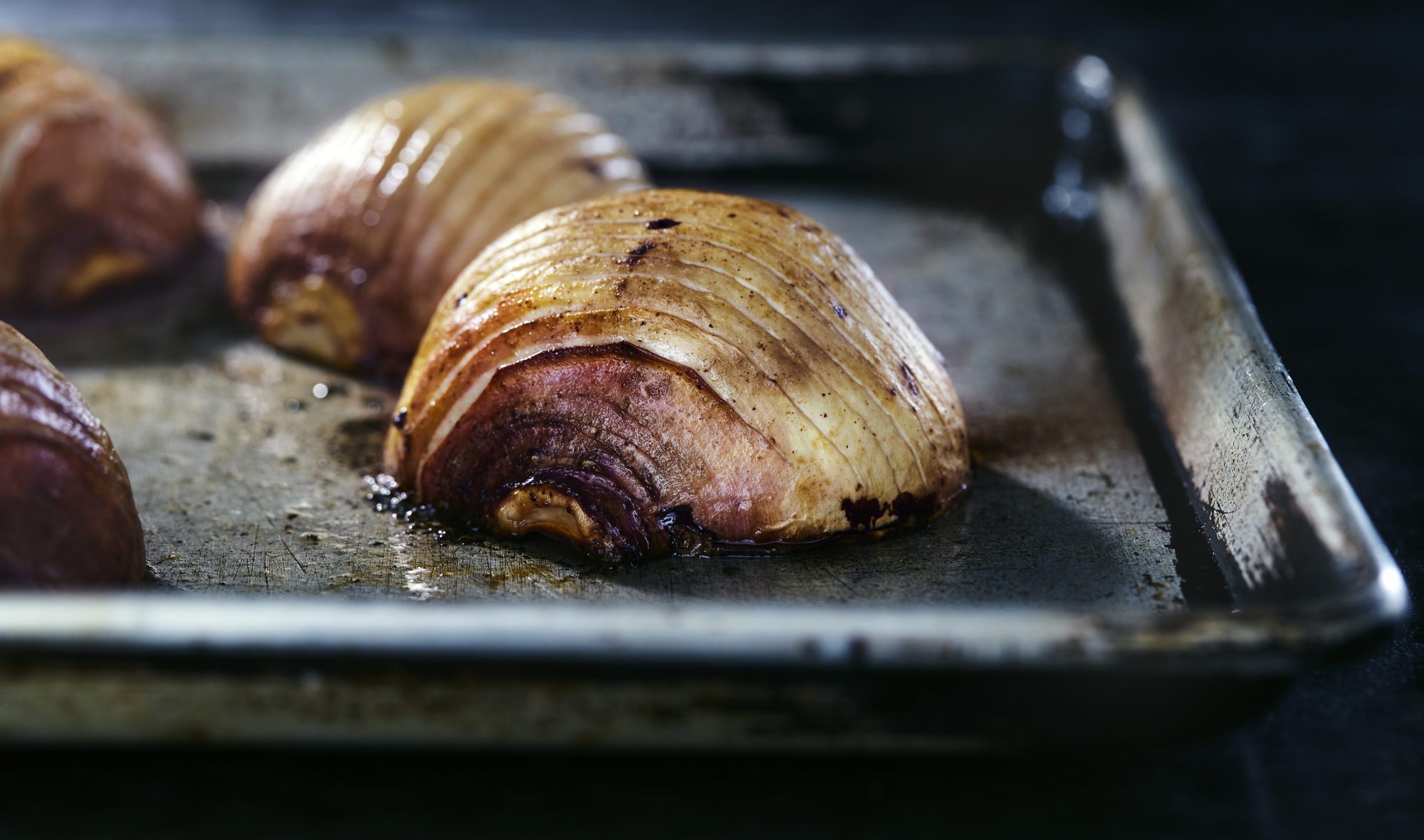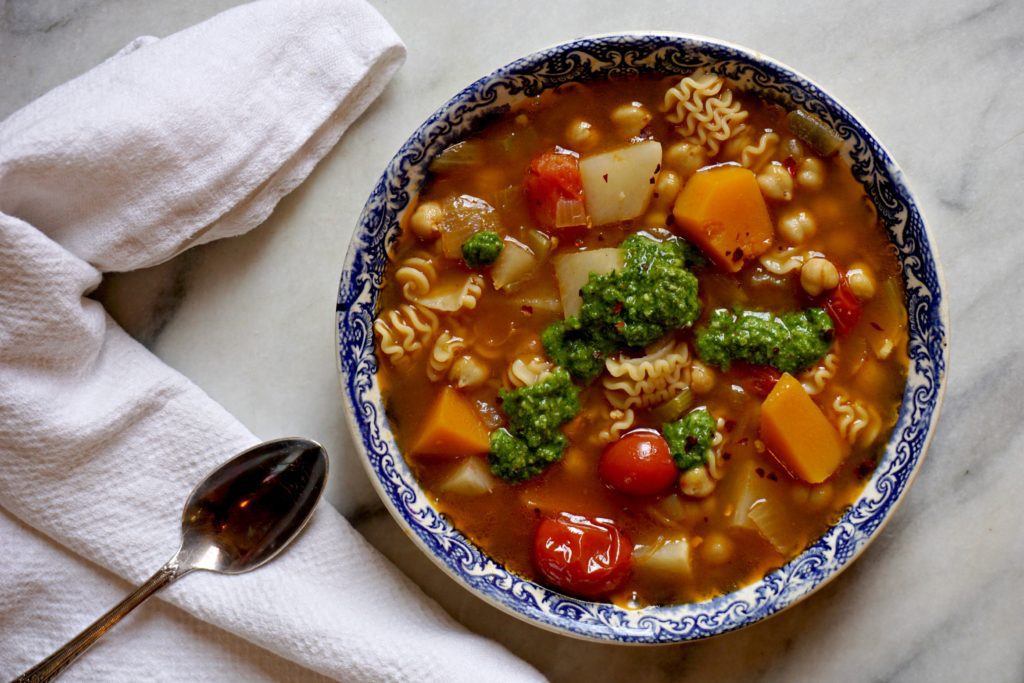
🎁 Holiday Special: SAVE 52% on the Nutrition Coach Starter Package. Limited number remaining.

🎁 Holiday Special: SAVE 52% on the Nutrition Coach Starter Package. Limited # left.

The turnip is a taproot, which is a root vegetable that grows downwards into the earth. Like other taproots, the turnip is a hearty vegetable that can grow in a range of temperature conditions. However, turnips do prefer cool temperatures and taste best after having weathered a touch of frost. For this reason, the turnip season in North America falls between mid-fall and spring. The turnip has an interesting dip-dyed color pattern. This is due to the fact that the top of the root often peeks above ground, while the bottom portion remains submerged. The part that receives sunlight will turn pale green or a blushing purple, while the underground part will stay pale and white. Like many vegetables, turnips are low in calories compared to their volume. In its raw form, it is a good source of vitamin C.
The turnip is a taproot, which is a root vegetable that grows downwards into the earth, acting as a storehouse of nutrients for the plant above. Other taproots include carrots, parsnips, radishes, and beets.
Like other taproots, the turnip is a hearty vegetable that can grow in a range of temperatures. Because its bulbous body grows underground, the soil insulates it and protects it from extreme conditions. However, turnips do prefer cool temperatures and taste best after having weathered a touch of frost.
The turnip has an interesting dip-dyed color pattern. This is due to the fact that the top of the root often peeks above ground, while the bottom portion remains submerged. The part that receives sunlight will turn pale green or a blushing purple, while the underground part will stay white.
Turnips are a part of the Brassica family, which also includes cabbage, rutabaga, and radish, and shares many flavor notes with these cousins. When properly prepared, it has a refreshing, slightly sweet taste with a delicate bitterness.
If overcooked, it smells like something you would blame on the dog.
Charmingly, in some parts of the United Kingdom, turnips are referred to as “neeps”.
Turnips are typically round and bulbous, although they can be more elongated too, like a thick carrot. The base of the turnip tapers into a little tail-like root, while the top is crowned by a bunch of leafy stems, which are also edible, although these are often removed.
The top half of a turnip bulb is colored. It can be pale green or a blushing purple. Inside, the turnip is crisp and white and has a slightly sweet, slightly bitter taste, similar to raw cabbage.
Particularly when roasted, cooked turnips are delicious and will caramelize slightly under the right conditions (high heat and fat), bringing out their natural sweetness.
One cup of cubed raw turnips (about 130g) has 36 calories, 1.2g of protein, 0.1g of fat, 8.4g of carbohydrates, 2.3g of fiber, and 4.9g of sugar. In their raw form, turnips are a good source of vitamin C.
Turnips are available at most grocery stores and fruit and vegetable markets, particularly when they are in season, which in North America falls between mid-fall and spring.
When selecting turnips, choose specimens that are smallish and heavy for their size. Larger, lighter turnips tend to be woody and less flavourful. The bulb should be firm and unblemished, and if the leaves are still attached, they should be springy and fresh looking, rather than wilted or browning.
If you have purchased turnips with their leafy tops still attached, snip them off and store them separately, as the tops will draw water from the bulb and reduce its crispness.
Store the tops, cut stems down, in a glass of water in the fridge for up to four days. Wrap the bulbs in plastic, and store for two to three weeks.
Once cooked, turnip greens and bulbs can be kept in the fridge for three to four days.
Alternatively, both turnip greens and bulbs can be frozen. Blanch them first in boiling water, then store them in an airtight container in the freezer for up to six months.
Young, fresh turnips can be eaten raw, and are particularly tasty when grated or thinly sliced and thrown into a salad.
However, turnips are usually cooked before they are eaten. They can be steamed, boiled, stir-fried, or roasted.
Roasting is a delicious method to bring out the natural sweetness in turnips, so if you are wary of this vegetable, try this preparation:
First, preheat the oven to 425 degrees Fahrenheit. Wash and cut the turnips into half-inch wedges, then toss them in a generous amount of olive oil. Scatter the wedges over a parchment-lined baking tray, sprinkle with nutmeg and a bit of salt, and then roast for about 30 minutes, flipping the wedges partway through to ensure even browning. The turnips are ready when they are golden on the outside and soft on the inside. Top with a sprinkle of parmesan for extra decadence, then serve.

There is no “official” recipe for minestrone soup. Instead, it is more of a method that combines whatever vegetables are in season with pasta and beans, to make a hearty soup. This version uses chickpeas instead of more traditional romano beans and is topped with a fresh parsley pesto.
Prep Time: 55 minutes Cook Time: 20 minutes Yield: 6-8 servings
For the soup:
Add olive oil to a large pot over medium-high heat. Add onions and garlic, and cook until fragrant and soft, about 5-7 minutes. Add tomatoes, and cook until they begin to blister and break apart, about 5 minutes. Add celery, and cook for another 5 minutes, stirring occasionally.
Add cubed turnip, butternut squash, bay leaves, broth, and chickpeas, and bring liquid to a simmer. Simmer, covered, for about 15 minutes, or until the turnip and squash are tender but not falling apart.
As the soup is simmering, you can cook the pasta (follow the package directions to cook to al dente) and make the Lemony Parsley Pesto (see recipe below).
Once soup is done simmering and pasta is cooked, drain pasta then add to soup. Stir to combine.
Add salt and pepper to taste, and then portion into individual bowls. Top with a dollop of parsley pesto, and serve while hot.
For the pesto:
Add all ingredients to a blender or a food processor and process until a mostly smooth, yet still slightly textured mixture. Set aside and serve as a topping over soup.
Precision Nutrition’s Encyclopedia of Food expands every single month as we highlight new foods and showcase beautiful food photography. If you’d like to stay up to date, simply click this link. From there, we’ll send you a FREE copy of our recipe book. We’ll also let you know when new and delicious foods are added to the site.
The turnip is a taproot, which is a root vegetable that grows downwards into the earth. Like other taproots, the turnip is a hearty vegetable that can grow in a range of temperature conditions. However, turnips do prefer cool temperatures and taste best after having weathered a touch of frost. For this reason, the turnip season in North America falls between mid-fall and spring. The turnip has an interesting dip-dyed color pattern. This is due to the fact that the top of the root often peeks above ground, while the bottom portion remains submerged. The part that receives sunlight will turn pale green or a blushing purple, while the underground part will stay pale and white. Like many vegetables, turnips are low in calories compared to their volume. In its raw form, it is a good source of vitamin C.